Research
These pages will no longer be maintained from 13.12.24.
You can find the web presence of the Chair of Computational Mechanics at www.nm.ovgu.de
Development of a Design Tool for Flow Diverter Devices
- Trivariant NURBS representation of Flow Diverter Devices
- Contact simulations based on Isogeometric Analysis
- Explicit and implicit transient computations
- Shape Memory Alloys
- BMBF joint research project BELUCCI
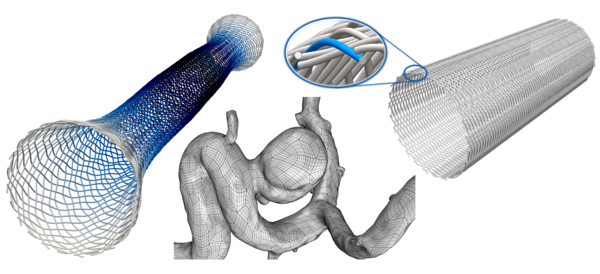
Active and passive vibration and noise reduction on machines and structures
- Design, simulation and testing of active controlled systems
- Design optimization using passive measures

- Vibration and acoustic measurements
- Measurement of frequency-dependent material parameters (stiffness and damping)
Modeling of fracture mechanics
- Phase field methods
- Brittle fracture
- Ductile fracture
- Crack propagation in polycrystalline materials
- Crack propagation in rubber-like materials, large deformations
- Crack propagation with the help of adaptive Finite-Element-Methods
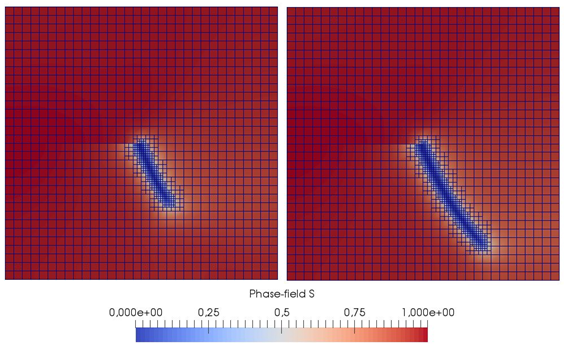
Analysis of electrical drives and machines
- Computation of electromagnetic stimulation and performance
- Usage of this performance studies for numerical vibration analysis

- Calculation of acoustic behaviour of the electrical machines
- Comparison of different configurations to identify the optimal design
Development of new computational methods and software solutions
- Finite element methods for nonlinear and complex problems
- Explicit and implicit transient computations
- Finite element methods with high-order shape functions (p-FEM, SEM, IGA)
- Fictitious area methods (FCM, SCM)
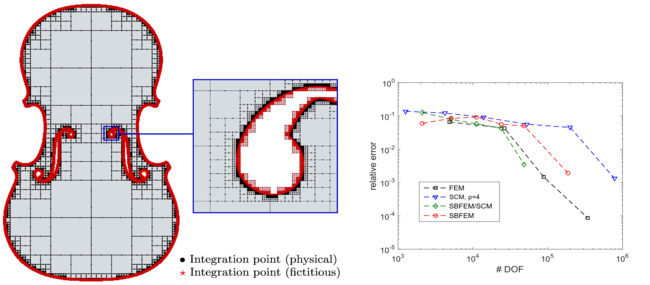
- Semi analytical methods (SAFE, SBFEM)
- Multi-field problems (Thermo-Piezoelektrizität, Fluid-Struktur-Interaktionen)
- Structural computations/-optimization (strength, crash, stability, acousitcs, heat conduction, electromechanics)
- Medical engineering and biomechanics
Mechanical characterization of materials
- Phase field methods
- Computation and design of fiber composite structures (CFK, GFK) and sandwich sttructures
- Micro-macro models
- Numerical homogenization methods
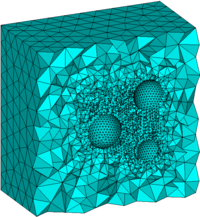
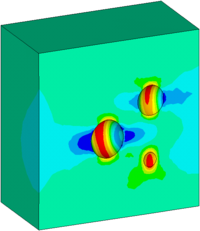
- Fiber and particle reinforced materials, foams, porous media
- Continuum mechanics
- Extended material modeling
- Elastomers
Modeling of mixing and demixing processes
- Phase field simulations
- Diffusion models including the interface energy
- Mixing behavior of polymers
- Mixing behavior in the presence of mechanical loads

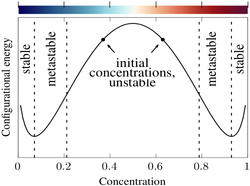

- Investigation of the influence of the kinematics at large strains
- IGA for sufficient inter-element continuity when dealing with higher order differential equations
Modeling of oxidation processes including mechanical couplings
- Phase field method for modeling oxidation processes
- Diffusion laws for simulating the oxygen supply to trigger oxidation processes locally
- Considering reaction kinetics

- Shrinkage caused by oxidation (cf. figure)
- Varying material properties dependent on the oxidation state
- Calculation of stress distributions due to local oxidation and shrinkage
Modeling of solidification processes
- Phase-field simulation of solidification processes using finite element methods
- In cooperation with Institute of Materials and Joining Technology (IWF)
Holistic simulation approaches for acoustic evaluation of components and machines
- Detailed analysis of the crank mechanism with the help of a elastic multi-body simulation
- Consideration of elasto-hydrodynamic interactions in the context of multi-body analysis
- Cooperation with Chair of Technical Dynamics

- Making the simulation results audible
- Evaluation considering the auditory perception of the human being
Evaluation of pores in castings
- Distribution of the pores are detected by CT scans and transferred to an STL dataset
- Pores are taken into account in load-relevant areas of the component in order to investigate their effect

- Cost-effective and reliable predictions regarding to material utilization and loading
- Inclusion of the microstructure of heterogeneous and cellular material systems in numerical analysis
Structural Health Monitoring (SHM), Ultrasnic waves/Lamb waves
- Use of high frequency guide waves for structure monitoring
- Particularly for fiber composite materials, damage monitoring is of great importance
- The methods can also be used for all other material classes
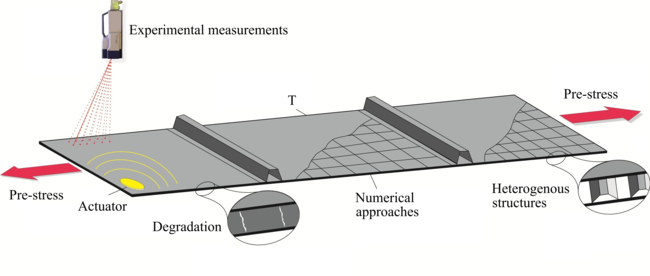
- Numerical and experimental analysis of wave propagation and damage mechanisms
- Simulation and design of piezoelectric sensor and actuator networks
Experimental Analysis
- Stress-strain measurements, strain gauges, hydro-pulse system, tensile tests
- Vibration and acoustic measurements (3D-Laservibrometer, Derotator, In-plane Vibrometer)

- Directional characteristic measurements in the far field
- Free field space, microphone arrays

- Measurement of frequency-dependent material parameters
- Impact hammer, accelerometer
Research projects of the chair
- under the direction of Prof. Dr.-Ing. Daniel Juhre
- under the direction of Dr.-Ing. Sascha Eisenträger
- under the direction of Prof. Dr.-Ing. Dr. h. c. Ulrich Gabbert
